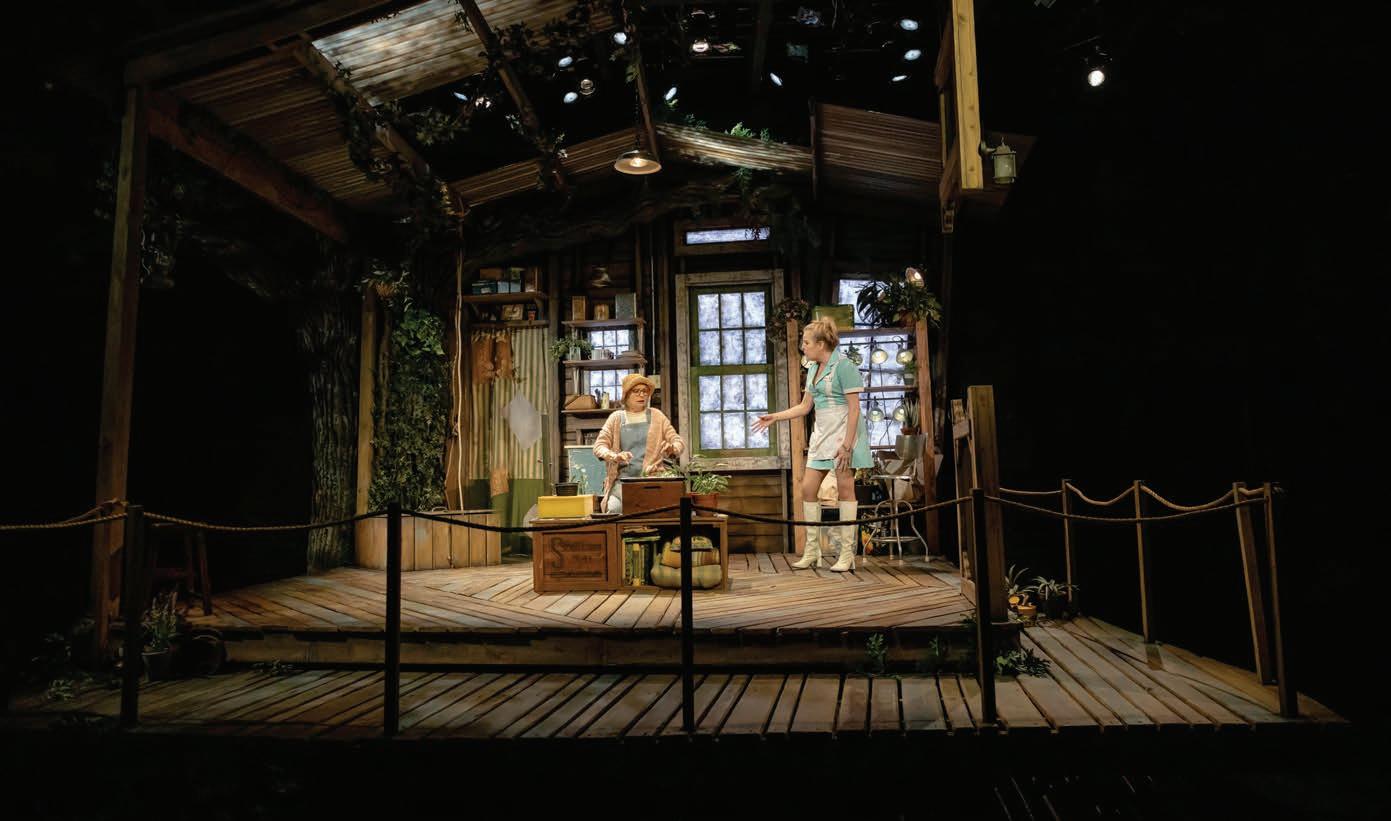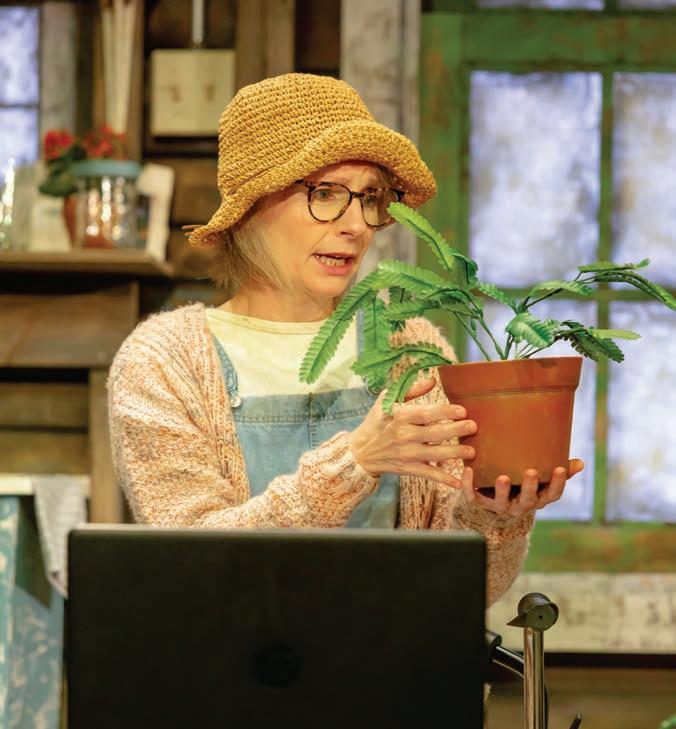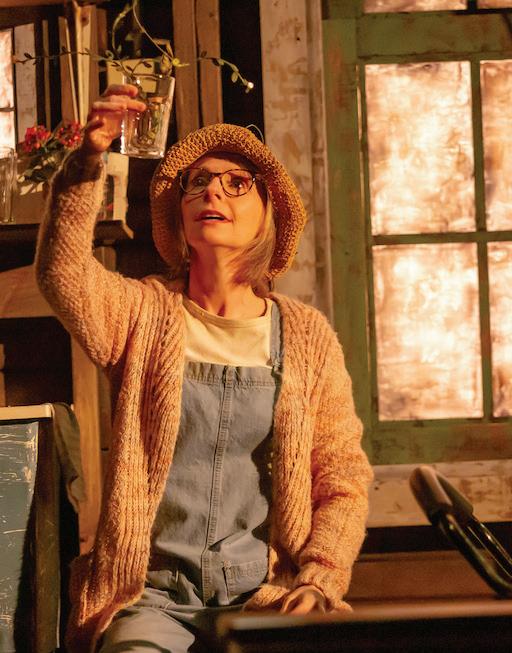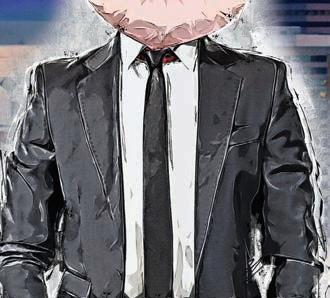
10 minute read
ARTS & CULTURE
ARTS &
CULTURE
Missy Mazzoli
PHOTO: MARYLENE MAY
New Music
Composer Missy Mazzoli’s world premiere concerto with the Cincinnati Symphony Orchestra puts the violin at center stage
BY ANNE ARENSTEIN
Missy Mazzoli is no longer “the 21st century’s gatecrasher of new Classical music,” as NPR proclaimed in 2018. She’s now rmly inside the seemingly intractable fortress — an acclaimed composer whose works are commissioned and performed by major ensembles throughout the world.
On March 11 and 12, the Cincinnati Symphony Orchestra will present Mazzoli’s violin concerto — “Violin Concerto (Procession)” — a co-commission with the National Symphony Orchestra, performed by Mazzoli’s frequent collaborator Jennifer Koh.
During the concert, the May Festival Chorus will also sing Mozart’s “Mass in C Minor.”
“ is is the rst orchestral piece I’ve written with the violin speci cally in mind,” Mazzoli tells CityBeat, although she has several works for solo violin, including a commissioned fanfare for CSO concertmaster Stefani Matsuo.
Mazzoli’s concerto is also the latest in a series of collaborations with Koh, which began in 2010 when Koh asked Mazzoli to participate in her “Bach and Beyond” project, a program combining Bach’s Sonatas and Partitas for violin with newly commissioned works referencing speci c Bach pieces.
Mazzoli’s response was “Dissolve, O My Heart,” commissioned by the Los Angeles Philharmonic, based on Bach’s “Chaconne from the Partita in D minor.” Mazzoli writes on her website that although the task was “utterly terrifying,” she was inspired by Koh’s approach to Bach through the lens of contemporary music.
In the last decade, Mazzoli has written several short solo pieces for Koh. Most recently she penned “Hail, Horrors, Hail,” commissioned by the ARCO Group — Koh’s Classical music inclusivity nonpro t — as a response to COVID-19 isolation, as well as the 2020 “Alone Together” series.
A violin concerto seemed like the obvious next step, but Mazzoli says the composition evolved over years of discussion, shared co ee and Chinese food.
Speaking from her apartment in Brooklyn, Mazzoli says that conversations began with what form a concerto would take.
“I asked Jen what her role feels like when she stands in front of an orchestra in a dramatic sense. And over the years, an idea began to take shape,” she says.
Mazzoli and Koh continued scrutinizing the concerto form itself, questioning the soloist’s role, and gradually the concerto began to develop. At that point, the composition was purely an independent project, and Mazzoli credits both her and Koh’s managements with helping to secure the CSO and the National Symphony as co-commissioners.
Attendees shouldn’t expect to hear a conventional concerto with themes, variations and elaborate cadenzas and orchestral accompaniment.
“Missy’s work questions whether the soloist is leading the orchestra or within the ensemble,” Koh says. “It’s musical questioning that’s communicated in a very musical way.”
Although “Violin Concerto (Procession)” is purely instrumental, Mazzoli’s work in opera serves as a powerful in uence. She says “creating

Violinist Jennifer Koh with the Cincinnati Symphony Orchestra in 2016
PHOTO: MARK LYONS
a mini-drama for each movement” helped her with structure.
“A concerto has an interesting relationship between the one and the many, and that suggests a lot of dramatic scenarios,” Mazzoli says. “ e soloist can be leading and guiding the orchestra through something or be in opposition to them, or the orchestra can engulf the soloist.”
“Each movement took on one of these relationships and explored it to its ridiculous end,” she continues with a laugh. “It’s not absurdist at all. is isn’t a funny piece, just in an extreme way.” e opening movement, “Procession in a Spiral,” has the soloist taking the spiral to an extreme, Mazzoli says. “ e movement starts with this spiral with a wide range that collapses in on itself until we’re left with the violinist soloing at the end of the movement.” e second movement is inspired by the neurological condition known as St. Vitus’ dance, in which the su erer’s muscle groups move irregularly or involuntarily. “ e violinist leads the orchestra through this maniacal dance, accelerating into a tempo that’s almost impossible to play,” Mazzoli says. e concerto concludes with another procession, this time ascending “into heaven or in nity,” she says
Mazzoli and Koh had a unique opportunity to workshop the concerto at e Juilliard School, where Koh serves as a creative partner. Koh, a longtime advocate for new works, says that the workshop sessions were revelatory for both performers and composition students.
“ ere’s an incredible amount of trust between Missy and me, and they picked up on that. It was important for the kids to see how the best collaborative processes happen,” Koh says. “A lot of ideas were ying back and forth.”
Both accomplished artists bring perspectives as people who have led ensembles and performers. And for both, collaboration is essential.
“I tell composers that as violinists, we spend our lives learning the standard rep, but we interpret them in new ways,” Koh says. “Missy and I are specialized and have a great deal of knowledge of what is complicated and what works, both in terms of a composition and the players involved.”
Koh’s last performance with the CSO was in 2016, and she is looking forward to returning. Mazzoli will be in the audience for the performance, but her music debuted at the CSO in 2020, with “Fanfare for the Unimpressed” for the orchestra’s Fanfare Project, an initiative that commissioned more than a dozen composers to write works for solo instruments.
One of Mazzoli’s childhood dreams was ful lled when her hometown Philadelphia Orchestra, led by Yannick Nezét-Séguin, performed her haunting, dreamlike “Sinfonia (for Orbiting Spheres)” in December — a piece also performed by the Los Angeles Philharmonic, the New York Philharmonic and during the BBC Proms series at Royal Albert Hall in London.
“I didn’t realize what it meant to me until I walked onto the stage with the musicians,” Mazzoli says. “It’s exciting, really a dream. I’m grateful the work can exist in lots of di erent environments, in multiple spaces.”
And now Mazzoli is ready to experience the performance of her “Violin Concerto (Procession)” at Cincinnati’s Music Hall.
“Hearing my music performed is really an out-of-body experience. I’m always listening for what I can improve during rehearsals. But during the concert I try to let it wash over me,” she says.
“I really love that tension of hearing it in front of an audience and not knowing what they’re going to think or how it’s going to come o .”
The Cincinnati Symphony Orchestra will perform Missy Mazzoli’s “Violin Concerto (Procession)” March 11 and 12 at Music Hall (1241 Elm St., Overthe-Rhine). More info and tickets: cincinnatisymphony.org
ONSTAGE
REVIEW BY RICK PENDER
L to R: Tarah Flanagan as Emery Harris and Tasha Lawrence as Hazel in Rooted, a world premiere at the Playhouse in the Park

PHOTO: MIKKI SCHAFFNER
Deborah Zoe Laufer’s world-premiere play, Rooted — a commission presently onstage at the Playhouse in the Park — is a beguiling work. At rst, its three o beat women feel a bit like characters in a sitcom, and they’re certainly the source of much laugh-outloud humor. But before long, a rather profound message about belief and connection comes through, making this 95-minute show genuinely satisfying.
Emery Harris (Tarah Flanagan) is an eccentric amateur botanist. She’s lived in a treehouse in the branches of an immense oak tree for more than a decade, accessible only by climbing a rope and entering through a hatch that she keeps tightly secured. Despite her lack of scienti c training, she’s been conducting experiments to communicate with plants and posting her research on YouTube.
Emery’s pragmatic sister Hazel (Tasha Lawrence) has anger issues. She’s a waitress in a diner who’s bored and unhappy with life in the claustrophobic small town of Millerville. Hazel looks after Emery, paying bills and delivering food — but she is yearning to nd a way to escape and perhaps take her sister with her.
As it turns out, Emery’s research has developed a signi cant online following of people looking for emotional healing — they have decided she is something of a new-age messiah. Hundreds of them are ocking to the cow pasture shaded by Emery’s tree. One of the seekers, Luanne (Emily Kratter), a quirky, naive young woman, ends up in the treehouse, at rst as an unwanted guest and eventually as a catalyst for deeper understanding.
Emery, a serious recluse, has named a dozen or so of her plants — Stuart, Gioncarlo and more — and speaks with them as she attempts to understand their lives and reliance on one another. Laufer uses this as a metaphor for the human need for connection, whether it’s rational or irrational. Similarly, Emery’s followers, camping nearby, chant for her to come and speak to them. She really wants them to leave her alone, but Hazel sees this chaotic cult as an exit ramp from Millerville. While Hazel seizes the opportunity, Luanne and Emery nd themselves sliding into a meaningful friendship.
Created with a strong whi of magical


Emery Harris becomes a new-age messiah by accident in Rooted.
PHOTO: MIKKI SCHAFFNER
realism, the delightful treehouse set, designed by Se Hyun Oh, is as much a character as the women are.
At several moments, Emery’s linkage to the natural world is evocatively portrayed. e design incorporates an outside balcony across the front perimeter of the Playhouse’s Rosenthal Shelterhouse stage, and each of the women come out occasionally to address or be stupe ed by Emery’s worshipers, represented by raucous crowd noise (Megumi Katayama is the sound designer and the source of some lovely musical underscoring). From that position, it is almost as if the audience is playing the crowd.
Directed by Noah Himmelstein, the three actresses deliver increasingly textured presences, ampli ed by colorful voices. Flanagan’s tentative Emery is endearing, cowed by the attention, shu ing around her tiny space using a walker. Her enthusiastic belief in science and her shock at this unexpected and largely mindless devotion are both real and touching, and her attachment to her plants makes her especially lovable.
Lawrence’s exasperated, boisterous portrait of salty and profane Hazel, who loves her sister but desperately wants some change in her life, evolves into an opportunistic schemer with some hilarious notions about how to build upon Emery’s fame.
Kratter played Luanne in 2018 at the Playhouse in the world premiere of another play by Laufer, Be Here Now. In that production she was a tirelessly optimistic and maddeningly cheerful co-worker of the cynical central character. She has retained those amusingly innocent qualities, but Kratter’s portrait makes her more thoughtful and emotionally whole as she comes to grasp what Emery is learning from her plants. e arc Laufer has created for this story takes theatergoers on a pleasant trip from humor to understanding. In her playwright’s program note, she writes that she’s focused on several themes — “the yearning for meaning and belief, the struggle to be truly present, the power of female friendship and what happens when you slow down and allow there to be quiet and connection in the midst of a chaotic, sometimes frightening world.” at strikes me as something we all need in 2022.

Rooted has its world premiere at the Rosenthal Shelterhouse Theatre at the Playhouse in the Park (962 Mt. Adams Circle, Mount Adams) through March 20. Tickets start at $30. More info at cincyplay.com.




You can enjoy FREE* grocery delivery, 2X Fuel Points and more
for as low as $59/year.**
Sign up at Kroger.com/boost
*$35 order minimum. Restrictions apply. Subject to availability. Delivery time not guaranteed.
WE’LL BEAT YOUR RATE BY 1% OR MORE!*
Refinance your auto loan with TruPartner and you could save hundreds of dollars!
Check your rate, refinance with TruPartner and start saving every month!



